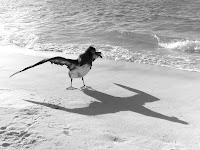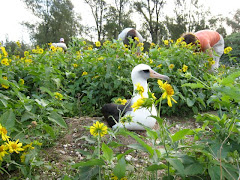





Aloha mai e kuu mau hoa makamaka,
Tonight is the last night I will sleep on Pihemanu. In all honesty, I'm not ready to come home. A few of the PAA ohana are still awake in the lobby of Charlie Barracks with me as we cherish our last night together and hang onto this space and time. Earlier tonight, the crew shared some beers and good laughs, the kind that make your stomach hurt so bad that you realize that you haven't laughed that hard in a while. And you suddenly realize you have exactly what you need, no more and no less. In under twenty four hours we will all be in our seats on the the plane (G1) heading for O'ahu.
To me, Pihemanu is a work of art. Everywhere you look it is virtually impossible to deny her beauty. In many places around the atoll, her abundance, wealth, life, and depth is juxtaposed against a history warfare and military occupation while Midway atoll served as a strategic battleground and front in the middle of the Pacific in WWII and the Cold War.
There is not a single person on this trip that allows a way for the wonderment, aloha (love) and fascination for this place escape them. Each individual's experience is the same in this way. In fact, as our time here progresses we arrive with new questions and inquiries like any young child would. So, what this means is on Pihemanu we're granted a second chance, maybe third to start all over again and rediscover a new place through the eyes of a child. Some of our questions can be answered with simple facts and others may require us to ponder. To say the least, it has become easy for me to forget about my life back home which affords me to look inward and re-examine my kuleana as a Native Hawaiian, marine conservationist, educator, lifelong student, and global citizen. But, I remember each day that these moments are precious and I trust that my kuleana that builds upon the southeastern horizon is something that I can fulfill in this life.
The focus of my inner dialogue brings me to share a few things with you about my relationship with the kai (ocean). My earliest memories of the ocean take me back some twenty five or so years ago. I remember my father, holding me with his hands under my belly instructing me through my first series of swimming lessons. I must have been instantly drawn to the water because I have never fallen out of love with the ocean. As a child I also have fond memories of snorkeling at Hanauma Bay and it was there where I first discovered life below the surface. At that time, visitors to the bay could still feed the fish with little pellets they used to sell there. As most of you know, times have change and people can no longer feed the fish. For those of you who live in urban Honolulu, I encourage you to visit this special place. As the ocean's baseline continues to shift for the worst and fish stocks and coral health decline pu'u honua (refuges) like Hanauma and Papahanaumokuakea remind me of the power of protecting a place in perpetuity for its biological, cultural, and social significance and its power to heal not only nature but mankind itself.
When I am in the ocean whether it's surfing, paddling, fishing, snorkeling, swimming, or diving I feel that my great grandfather is with me. He was a man of the ocean and my father and uncles speak admirably about their grandfather who knew so much about the place that he loved. It is only later in life that I began realize that it's not a mere coincidence that I find myself in the same line of work my grandfather was doing as a fish and game warden some 50 to 60 years ago. As my dear hoa (friend) and fellow PAA member, Nai'a, shared, "[we] don't get kuleana from no where".
And so, my journey to Pihemanu is related to my genealogy which for me includes all my ohana (family), ku'u mau hoa( dear friends), my new PAA ohana, and countless others who put tremendous time and energy into mentoring me. My only hope is that I'm able to represent you well here and bring you as close as I can get you to Pihemanu. And so in my last letter to you before I depart from this remote atoll that lies in the great expanse of the Pacific Ocean, I will try my best to take you on one of my journeys into her waters.
There are two places on the atoll where we may explore the underwater world here. All other beaches are reserved for species that are endangered. The light blue waters off of North Beach are the most inviting waters I've ever seen. Conversely, the cargo pier, towards the eastern side of the atoll is an artificial marine habitat created several years ago through the creation of a channel to bring big ships to the atoll. Just a few feet from the sandy shores of the cargo pier, it drops off 50 to 60 feet and gives the feel of a blue water dive. The underwater experience at the cargo pier is a rare one. It feels like a kaleidoscope, so many things happening all at once, and when the much welcomed rays of sunlight illuminate the eerie and murky waters under the pier one feels a little more inviting. The fish are abundant, some are familiar to me, many are not, and some are really big. And so in this manmade habitat there is a mixture of nearshore and deeper water fish species that coexist. In all my time spent diving reefs around the main Hawaiian Islands, never have I seen fish in such abundance in a small concentrated area.
If I count all the hours and pictures I've spent snorkeling under the pier it probably adds up to something like two hours and 800 pictures. All that Pihemanu has revealed to me is not an accident, its a combination of our pule (prayers), the power of intent and manifestation. And so I will leave you with this short story about a special fish to me.
Last week Monday, during PAA's visit behind the scenes of Bishop Museum's incredible fish specimen collection, before exiting the room I kindly asked our guide if they had a preserved specimen of the hapu'u fish. Since it's been virtually fished out of the main Hawaiian Islands and the primary reason why it is such a rare sight, I thought here's my chance to see what it looks like in "real" life. Yesterday, not even ten minutes into our daily snorkel under the pier, I came across the hapu'u not knowing it at the time, got close to it and snapped a photo. After downloading my photos and looking through them (as we obsessively do here on Pihemanu), I found that shot and a sudden feeling of "chicken skin" came over me as I realized what I had seen today. This is life on Pihemanu. Every experience and moment on is a gift, is precious, and is teaching each of us something.
I wish I could share all my stories with you and I look forward to sharing more with you in person. I will see you all soon.
"He wa'a, he moku, he moku, he wa'a"
me ke aloha no,
Marion

















so beautiful, marion. thank you for letting me see it through your eyes.
ReplyDeletemahalo nui, e Marion!
ReplyDeleteThank You Marion...
ReplyDelete